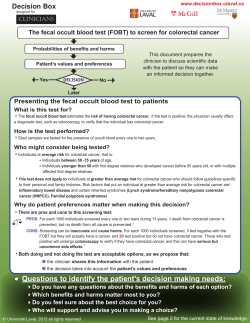
} Investment in r esear ch saves l ives and money Today:
#1 in a ser ies Investment in r esear ch saves l ives and money facts about: } Cancer updated 2013 “I“Iff you you think thinkresearch researchisisexpensive, expensive, try trydisease.” disease.” — Mary Lasker 1901–1994 — Mary Lasker 1901-1994 Today: The Cost: :: In the US, more than 1.6 million people were expected to develop cancer in 2012, with a lifetime probability of 1 in 2 men and 1 in 3 women being affected.* :: As the second leading cause of death in the US, cancer led to approximately 575,000 deaths in 2012, equivalent to almost 1,600 deaths per day.* :: Cancer is the leading cause of death among Hispanics.* :: Cancer death rates are highest among African Americans, followed by Caucasians, Native Americans, Hispanics, and Asian Americans.** :: An estimated 12,000 children between ages 0-14 are expected to be diagnosed with cancer in 2012, and 1,340 will die from the disease.* :: Annual direct and indirect (due to illness related loss of productivity or early death) costs of cancer totaled $263.8 billion in 2010.* :: A study funded by the National Institutes of Health projects that, based on current trends, the annual cost of treating cancer will increase 27% to $158 billion by the year 2020.* *SOURCE: AMERICAN ASSOCIATION FOR CANCER RESEARCH (WWW.AACR.ORG) **SOURCE: NATIONAL COLORECTAL CANCER ROUNDTABLE (WWW.NCCRT.ORG) sur vi vor : *SOURCE: AMERICAN CANCER SOCIETY (WWW.CANCER.ORG) **SOURCE: CENTERS FOR DISEASE CONTROL AND PREVENTION (WWW.CDC.GOV) Andrea Kramer 52 CONDITION: Colorectal Cancer STAGE: III NAME: S A VI N G L I V E S S A VI N G M ON E Y HOW RESEARCH SAVES LIVES: :: Over the past 40 years, mortality rates for childhood cancer have been reduced significantly, dropping 66% during this time period due to early detection techniques and treatment.* :: In a study funded by the National Cancer Institute, among bone marrow cancer patients receiving a bone marrow transplant, patients taking lenalidomide, a drug which inhibits factors that cause inflammation, experienced nearly 60% slower disease progression than those who received a placebo.* * SOURCE: AMERICAN CANCER SOCIETY (WWW.CANCER.ORG). ** SOURCE: MCCARTHY PL, ET AL. NEW ENGLAND JOURNAL OF MEDICINE. 2012. 366:1770-1781. AGE: A physically active mother of two, Andrea started experiencing stomach problems right before a trip overseas. She visited a gastroenterologist where she lives in Rye, New York. Among the tests performed by the gastroenterologist was a colonoscopy he recommended to “rule out some possibilities.” Expecting a diagnosis of colitis, Andrea and her family were shocked to learn that at age 47, she had stage III colorectal cancer. For the next year, Andrea underwent aggressive treatment, first with radiation and chemotherapy, followed by surgery. After surgery, twenty-six of her lymph nodes tested positive for cancer and further chemotherapy was given. Support from her family and friends and the excellent work of her doctors helped her through this ordeal. HOW RESEARCH SAVES MONEY: :: Eighty-three percent of lung cancer cases are directly due to smoking. In a ten year study examining smoking cessation programs, it was estimated that for every dollar spent on the programs, more than five dollars were saved. During this period, more than $1.5 billion was saved due to prevention of hospital visits. This health services research affirms the cost effectiveness of smoking cessation programs to help shape policymaking.* :: Screening 50 to 64 year olds for colorectal cancer could translate into Medicare savings of $15 billion over 15 years through prevention and reduced treatment costs.** Her experience at the hospitals made her realize that not enough is being done for colon cancer, and “there are not enough people out there raising money or talking about it.” Andrea kept telling herself, “If I survive, I am going to do something.” *SOURCE: DILLEY JA, ET AL.AMERICAN JOURNAL OF PUBLIC HEALTH. 2012. 102:E22-E28. “Raising money for colorectal cancer research is what is nearest and dearest to my heart as a survivor.” **SOURCE: NATIONAL COLORECTAL CANCER ROUNDTABLE (WWW.NCCRT.ORG). In the US, colorectal cancer is the second leading cause of cancer death. More research is needed to improve survival rates. Andrea is now raising awareness and funding for colorectal cancer through several organizations including Fight Colorectal Cancer, American Cancer Society, and Colon Cancer Alliance. Cancer Hope for the Future: :: Repurposing of the drug metformin, typically used to treat type 2 diabetes, is providing positive outcomes for several cancers including liver, prostate, and skin.* :: Use of genetic information to personalize drug therapy is providing encouraging results in children. In patients with a type of blood cancer, physicians can determine if the child will respond positively based on genetic information.** *SOURCE: SOURCE: AMERICAN ASSOCIATION FOR CANCER RESEARCH (WWW.AACR.ORG) **SOURCE: NATIONAL CANCER INSTITUTE (WWW.CANCER.GOV) The Bottom Line: Research offers the best defense against the staggering toll cancer takes on American lives and on our economy. Cancer research is providing insight into targeted treatment options that can reduce costly ineffective care. Also, research is discovering new tools to achieve a higher rate of early diagnosis which can reduce costs by improving survival rates. Continued funding is crucial as researchers make amazing progress in combating the spectrum of cancers that place Americans at risk. Quality of Life Has Been Improved By Medical Research, Voters Say Thinking of the last decade, would you say your quality of life has been improved by medical research? 22% Yes, a great deal 44% Yes, somewhat 23% No 20% Not sure SOURCE: NATIONAL PUBLIC OPINION POLL, AUGUST 2012. JZ ANALYTICS FOR RESEARCH!AMERICA WITH SUPPORT FROM UNITED FOR MEDICAL RESEARCH Estimated Number of New Cancer Cases* and Cancer Deaths** for 2012 Source: American Cancer Society Cancer Facts & Figures 2012 1.5.1212
© Copyright 2025





















